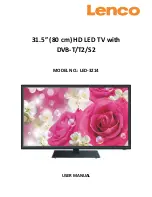
17
Resolution and picture quality
Broadcast wide screen films in different resolutions. The following table shows the resolution options for
wide screen film broadcast media.
Broadcast media
Resolution of the wide
screen signal
Analogue
cable TV
Digital
cable TV
DVB-T Satellite
(DVB-S)
DVD
HDTV
Satellite
(DVB-S2)
Blu-ray-
Disc
432i x 768 (Letterbox)
Yes
Yes
Yes
Yes
Yes
Yes
No
576i x 768 (anamorphic) No
Yes
Yes
Yes
Yes
Yes
No
720 x 1280 (HD)
No
Yes*
No
No
No
Yes
Yes
1080i x 1920 (HD)
No
Yes*
No
No
No
Yes
Yes
1080p x 1920 (HD)
No
No
No
No
No
No
Yes
Picture quality and black bars
Wide screen films come in different formats. The format is the relationship
between the width and height of the picture. For example, with a 16:9 film
the width to height ratio is 16:9 or 1.78:1. Only 16:9 films can fill a HD-
ready screen without black bars. Therefore, black bars are always visible
when a format other than 16:9 is received. E.g. 4:3, A 4:3 displays vertical
black bars to the right and left.
If a 4:3 picture is increased to 16:9 format then it either appears distorted
(see illustration) or some parts of the picture are cropped off at the top and
the bottom. This is completely normal and is not a fault in the wide screen
TV.
Super Cinemascope films are wider than 16:9 films. They are in the format
2.4:1 or 22:9, for example. This is clearly wider than16:9. Therefore, Super
Cinemascope films display black bars at the top and bottom on any HDTV
set.
Picture format and resolution
There is no connection between the picture format and the resolution received. For example, the Super
Cinemascope format can be received in all resolutions, even in the HD resolution1080ix1920. For HDTV
reception too an HDTV set may display black bars at the top and bottom.
4:3 picture 1:1 on
16:9 screen
4:3 picture zoomed on
16:9 screen
Picture size and resolution
* Digital Cable receiver with HDMI output required.
Best picture quality is achieved when the input signal has a resolution of 1920 x 1080i. If a signal with a lower
resolution is input (e.g. analogue cable TV), there is a visibly poorer picture quality.
This is understandable as, if the same picture quality were available at a lower resolution, the broadcasting
companies would not need to take the trouble to send the signal at the higher resolution.
Why are there different resolutions?
Analogue cable TV uses a standardised TV signal. Each analogue 4:3- tube TV, however old it is, can process
this signal. That is the advantage of standardisation. The disadvantage is that the resolution has not changed
since the end of the Second World War. The resolution has been max. 576 x 768 for over 60 years.
For comparision: today’s TVs feature a FullHD-resolution of 1080 x 1920.
The analog cable-network offers the 16:9-format at a low resolution of only 432 x 768. This input covers only 16%
of a FullHD-screen’s area. 84% of the screen would stay black, if the TV would not make up the rest by some
special mathematics. 84% of what you see had been made up artificially by magnifying the tiny input-signal to
full-screen-size. That’s the reason for the analog cable-network’s low picture-quality seen on every FullHD-TV.
3CX0501A_EN.indd 17
3CX0501A_EN.indd 17
10/8/10 4:00:36 PM
10/8/10 4:00:36 PM












































